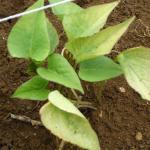Growing Sweet Potato, also Kumara
Ipomoea batatas : Convolvulaceae / the morning glory family
| Jan | Feb | Mar | Apr | May | Jun | Jul | Aug | Sep | Oct | Nov | Dec |
|---|
Not recommended for growing in New Zealand - cool/mountain regions
- Plant shoots or cuttings (Slips). Best planted at soil temperatures between 63°F and 95°F.
- Space plants: 16 - 24 inches apart
- Harvest in 15-17 weeks.
- Compatible with (can grow beside): Best in Separate bed
Sweet Potatoes require a long warm growing season. Plant in free draining loose soil. Fertilise before planting but no more when the plants are growing as it will encourage vine growth. They will go for miles and you will get no tubers. If they do start spreading, lift the vines off the ground to prevent them rooting.
Mound up the soil about 20 cm (8 in) before planting. Let the plants die down, (leaves die or turn yellow) before harvesting the tubers. Dry them in the sun for a few days. then store in a cool dry place for up to five months.
Culinary hints - cooking and eating Sweet Potato
Use mashed, boiled, roasted, baked or fried. Or use in soups, pies, casseroles, curries and salads.



Your comments and tips